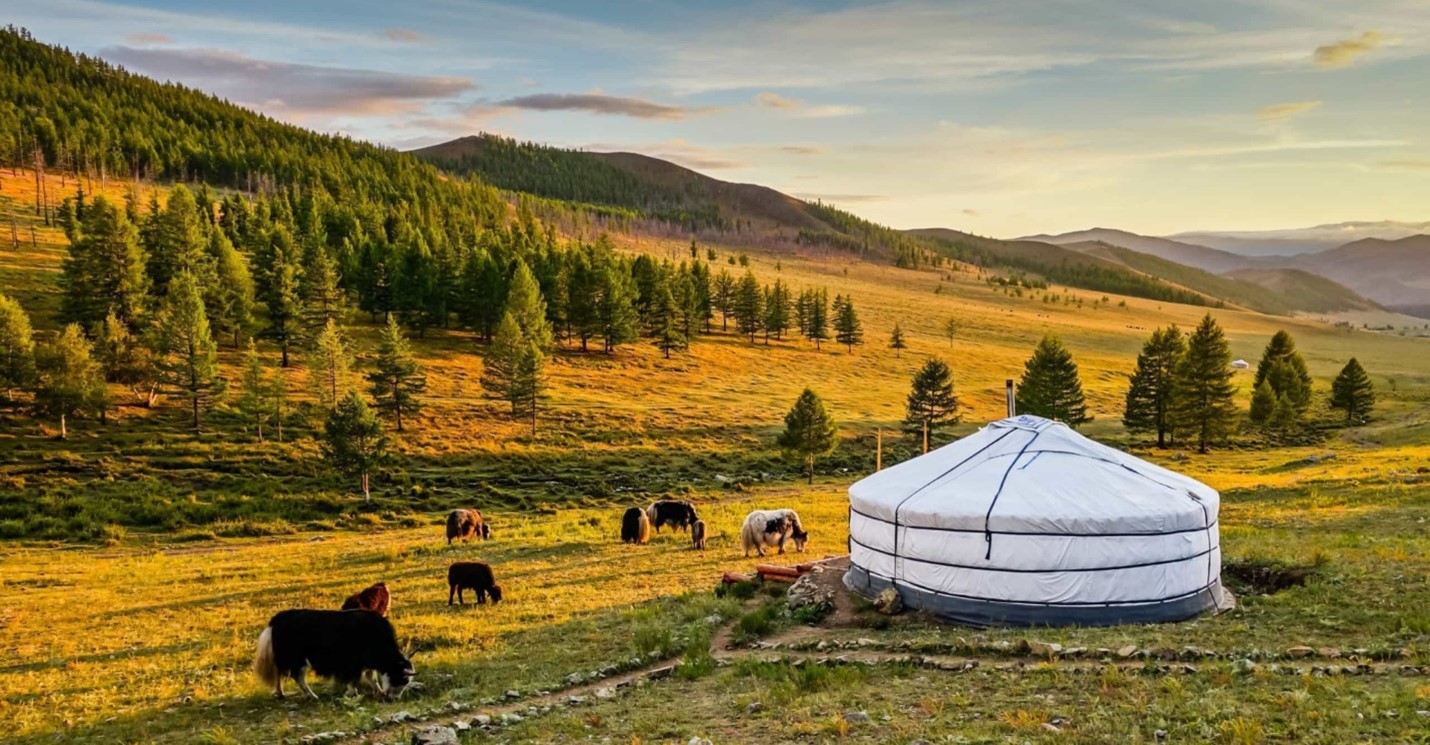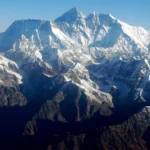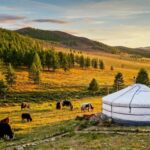When people think of Mongolia, vast grasslands, endless blue skies, and galloping horses immediately come to mind. Yet, beyond this familiar imagery lies a profound truth the Mongolian countryside is more than just a landscape; it’s a living heritage of simplicity, endurance, and connection with nature. In the first glimpse, countryside Mongolia reveals the untouched spirit of humanity where every sunrise over the steppe marks another day in harmony with the earth. This article takes you deep into that world, exploring the rhythm of life, the challenges, the beauty, and the quiet philosophy that shapes one of the last truly nomadic cultures on Earth.
Mongolia’s countryside stretches endlessly, with rolling plains merging into rugged mountains, dotted with solitary gers (traditional tents) and herds of horses, yaks, and camels. Unlike the buzzing pace of modern cities, life here flows with nature’s rhythm. Every aspect from herding animals to brewing milk tea echoes a dialogue between people and land. To understand countryside Mongolia is to understand the essence of balance a life guided by tradition, community, and adaptability. The Mongolian nomads have lived like this for centuries, and even as modernity slowly reaches the steppes, the countryside remains the heartbeat of the nation’s identity.
Key Aspects of Countryside Mongolia
| Aspect | Description |
|---|---|
| Geography | Vast steppes, mountains, deserts, and lakes covering most of Mongolia’s land area. |
| Main Livelihood | Nomadic herding: goats, sheep, yaks, horses, and camels. |
| Population Density | One of the lowest in the world—around two people per square kilometer. |
| Cultural Heritage | Deeply tied to shamanism, Buddhism, and nomadic traditions. |
| Climate | Extreme—temperatures can range from -40°C in winter to +40°C in summer. |
| Housing | Portable gers designed for mobility and resilience against harsh weather. |
| Food | Dairy-based diet: milk tea, fermented mare’s milk, dried curds, and meat stews. |
| Transportation | Horses, motorbikes, and 4x4s for long-distance travel. |
1. The Land: A Living Canvas of Contrasts
Countryside Mongolia is not just open space it is a living ecosystem that shapes its people’s mindset. The land stretches so far that time itself feels different. The steppe is not silent; it hums with the wind, the neighing of horses, and the distant bells of grazing sheep. In summer, the plains turn emerald green, dotted with yellow wildflowers. In winter, the land becomes a white ocean of snow, testing the endurance of both humans and animals. For the people who live here, the land is teacher, provider, and adversary demanding respect and offering beauty in return. The nomads read the land like a book: the color of the grass tells them where to graze, the shape of the clouds signals storms, and the tracks of animals reveal water sources. There are no fences, only invisible boundaries defined by instinct and ancient wisdom.
2. The People: Guardians of Nomadic Heritage
The people of the Mongolian countryside are known for their resilience and hospitality. To live in a land so harsh requires strength, but it also breeds kindness. Travelers are welcomed into gers with warm milk tea and open smiles. Nomadism is not just a way of life it is a philosophy. Families move several times a year in search of better pastures, packing their entire homes onto trucks or camels. Their lives revolve around their herds, which provide everything: food, clothing, and income. The countryside Mongolian values freedom, self-sufficiency, and interdependence freedom to roam, the self-sufficiency to survive, and interdependence with community and environment. Despite modernization, many young Mongolians still return to the countryside during summer, reconnecting with their roots.
3. The Ger: A Symbol of Circular Harmony
The ger, or yurt, is more than a tent it is an architectural marvel perfectly adapted to the countryside’s challenges. Its round shape resists strong winds, while its felt insulation keeps it warm in winter and cool in summer. Inside a ger, everything has symbolic placement. The northern section is sacred, often adorned with family heirlooms or a Buddhist altar. The western side is for men’s tools, while the eastern side holds women’s utensils and cooking items.
The ger embodies Mongolian philosophy: simplicity, symmetry, and unity with the world. It reflects how life in the countryside revolves around balance between nature and humans, past and future, spirit and survival.
4. The Animals: Lifelines of the Countryside
In countryside Mongolia, animals are family. Horses, especially, hold an almost mythical place. They are not just transportation but symbols of pride and spirit. Mongolian children learn to ride before they can read.
Each animal serves a purpose:
- Horses: For transport and racing.
- Goats and Sheep: Main sources of milk, wool, and meat.
- Yaks and Cows: For dairy and heavy work.
- Camels: Used in the Gobi for transport and wool.
Every morning begins with the sound of hooves and bells. Herding is a delicate art balancing movement and rest, ensuring pastures recover, and protecting animals from predators and snowstorms. To the countryside herder, animals are not property; they are partners in existence.
5. Seasons and Survival: A Cycle of Renewal
Life in countryside Mongolia is measured in seasons, not months. Each brings beauty and danger.
- Spring is renewal—animals give birth, and families prepare for long rides.
- Summer is abundance—grass is high, dairy production peaks, and families celebrate festivals.
- Autumn is preparation—meat is dried, felt is repaired, and herds are strengthened.
- Winter is survival—temperatures plummet, and storms called dzuds can devastate entire herds.
Survival in the countryside requires foresight and collective effort. Families depend on one another, sharing food, labor, and compassion. It is this unity that sustains them through the harshest conditions.
6. Festivals: The Spirit of the Countryside
Despite their modest lifestyle, Mongolians love celebrations. The Naadam Festival, held each July, is the countryside’s most anticipated event. It features the “Three Manly Sports”—horse racing, wrestling, and archery.
Each event reflects centuries of tradition:
- Wrestling embodies strength and pride.
- Horse racing celebrates endurance and freedom.
- Archery honors precision and harmony.
During Naadam, the countryside becomes alive with color children racing bareback horses, women preparing feasts, and men testing their strength. It’s a time when the entire nation reconnects with its roots.
7. Food: A Taste of the Steppe
Countryside Mongolian cuisine mirrors its landscape: hearty, simple, and resourceful. The diet is built around animal products, reflecting the scarcity of crops in the steppe.
Popular countryside dishes include:
- Buuz – steamed meat dumplings.
- Aaruul – dried curds rich in protein.
- Airag – fermented mare’s milk, a national drink.
- Tsuivan – noodle stir-fry with meat and vegetables.
Meals are less about indulgence and more about nourishment. Every ingredient is cherished, for in the countryside, nothing is wasted, and everything has meaning.
8. Modern Challenges: Between Tradition and Transition
As roads expand and technology reaches even the most remote areas, countryside Mongolia stands at a crossroads. Younger generations are drawn to cities like Ulaanbaatar in search of education and stability. Climate change, too, threatens the nomadic balance bringing unpredictable weather and resource scarcity. Yet, resilience defines this culture. Solar panels now power gers, motorcycles replace horses for herding, and mobile phones keep families connected. The countryside is evolving, but not vanishing. Modern nomads are blending old and new keeping traditions alive while embracing the tools of the future.
9. Spirituality and the Steppe
Mongolia’s countryside life is infused with spirituality rooted in shamanism and Tibetan Buddhism. Every mountain, river, and stone carries spiritual energy. Before moving camps, families often offer milk to the spirits of the land. This deep respect for nature transcends religion it is an acknowledgment of coexistence. The countryside Mongolian lives not above the land, but within it.
10. The Countryside as a Mirror of Humanity
In a world obsessed with speed, countryside Mongolia offers a quiet reminder of what it means to be human. It teaches us that simplicity can be profound, that silence can be rich, and that life doesn’t need excess to have meaning. To visit or imagine countryside Mongolia is to glimpse a world that still breathes in sync with the planet a place where time pauses, and truth feels tangible.
Conclusion
Countryside Mongolia is not a relic of the past it’s a living philosophy. It represents continuity in an age of change, authenticity in a world of artifice, and humility in the face of vastness. As modernization reshapes landscapes and cultures across the globe, the Mongolian countryside remains a quiet testament to endurance, connection, and timeless grace. For those who seek to understand the essence of harmony between human and nature, the answer still lies somewhere on the steppe, beneath a sky that never ends.











